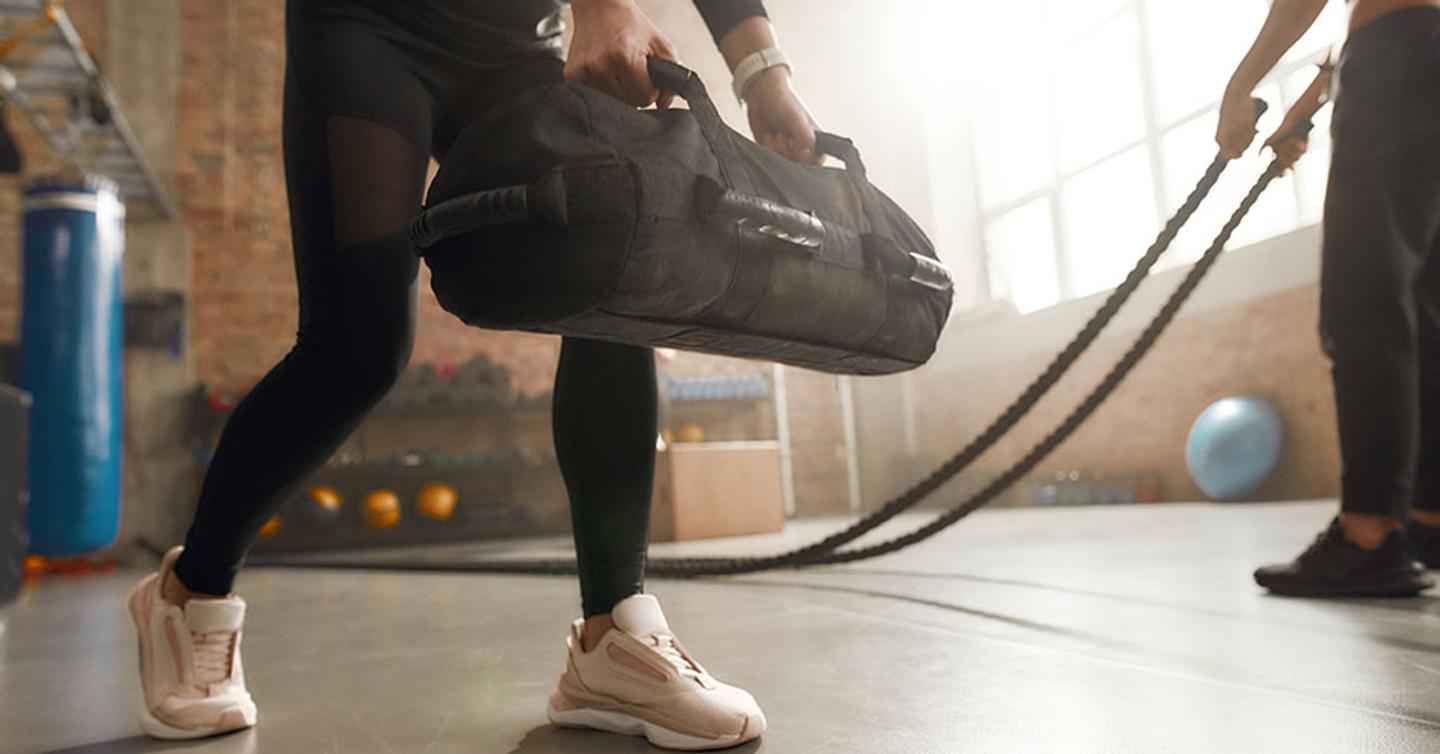
3 Lesser-Known Benefits of Sandbag Training
Reading Time: 5 minutes 8 seconds
BY: ISSA
DATE: 2022-12-08
When creating an exercise program, it is important to choose equipment that will help your clients reach their fitness goals. In the case of strength training, this often involves using machines or free weights. Another option to consider is a sandbag.
What Is Sandbag Training?
Sandbag training involves using a weighted bag during the exercise routine. In most instances, this bag is filled with sand, hence the term sandbag training. However, you can also fill a sandbag with other substances of similar weight. Other filler options include soil or small rocks such as pea gravel.
The top benefits of sandbag training include the following:
It can be done anywhere
The bags don't take up much space
It improves grip strength
It improves stability and sports performance
One of the nice things about sandbag exercises is that you can do them anywhere. This training tool can be used within a dedicated fitness facility or as part of a home gym. You can even use it outside in the park if this is where you provide your training sessions.
Plus, workout sandbags don't take up a lot of room. The weighted bag can be stored under a bed or in a closet if you don't have a lot of extra space. Or it can be stashed in a corner of the garage, where it is easily accessible for the next workout.
Some athletes like sandbag training for the benefits it provides. For example, sandbag exercise has been linked to increases in muscle strength and grip strength in particular. It has also been connected with greater levels of stability and improved sports performance. But there are additional benefits of using fitness sandbags that are less well-known.
3 Often-Overlooked Benefits of Using a Fitness Sandbag
Developing a sandbag workout offers clients more than just bigger muscles, better stability, and enhanced performance. Here are three additional often-overlooked benefits of weight training with a sandbag.
Benefit #1: Increased Post Workout Metabolism
Metabolism is the process in which food and drink are converted into energy. The higher your metabolism, the more calories you burn. The more calories you burn, the easier it is to obtain (and sustain) a healthier weight.
In a 2018 study, researchers analyzed the effects of sandbag training on metabolism. (1) It involved having subjects work out with a sandbag for 16 minutes. Three circuits were performed, each consisting of eight multiple-joint exercises.
When compared to running on a treadmill, the sandbag offered "a superior metabolic stimulus" for 30 minutes post exercise. That makes sandbag workouts beneficial to clients who want to drop a few pounds.
Benefit #2: Improvements in Functional Fitness
As a strength coach, you may already incorporate functional fitness exercises into your workout routine. A sandbag can be used to facilitate a functional movement pattern.
For instance, doing a Zercher squat with a sandbag mimics the same motion as picking up a piece of furniture as if to sweep under it. Performing a sandbag deadlift is similar to picking up a child who is running toward you. For the clients working in a tactical environment, this can help with all of the heavy equipment you need to move and haul around.
That makes this piece of equipment helpful to a functional training routine. Use motions that the client would normally engage in on a day-to-day basis. It will make those activities easier to perform.
Learn more: Why Clients Need to Prioritize Functional Strength Training
Benefit #3: A More Efficient Test of Athletic Conditioning
Some athletes and those working in a tactical environment are required to complete conditioning tests. These results indicate whether they are ready to compete in their sport of choice or perform their job.
According to a study published in the Journal of Strength and Conditioning Research, sandbag throws are an effective method for determining a client's conditioning level. (2) They also appear to provide a more sensitive result than some of the other testing options that exist.
In this study, the conditioning test was conducted on wrestlers. Use of the workout sandbag helped researchers better identify fatigue differences for athletes in different weight classes.
Implementing sandbag throws in your client's assessment can help you better determine their level of conditioning. This makes it easier to create an individualized workout program based on their current fitness.

The Ultimate Sandbag Training Routine
Research published in the Strength and Conditioning Journal outlines an effective 4-week sandbag training program. This workout is considered ideal for clients with strength training experience. It involves using a weighted bag three days per week and the sequence looks like this (3):
Week 1:
Day 1 - seated sandbag front squat, sandbag carry, barbell overhead press, dumbbell lunge, dumbbell curl
Day 2 - sandbag front squat, sandbag skull crushers, dumbbell bent-over rows, dumbbell farmer's walk, front planks
Day 3 - sandbag front squat, dumbbell overhead press, sandbag drag, sandbag shoulder toss, Russian twists
Week 2:
Day 1 - dumbbell lunge, sandbag skull crushers, dumbbell curl, dumbbell bent-over rows, sandbag squat
Day 2 - Russian twists, front plank, sandbag carry, sandbag slams, sandbag up-rows
Day 3 - barbell overhead rows, sandbag front squat, sandbag slams, Russian twists, sandbag carry
Week 3:
Day 1 - dumbbell carry, sandbag farmer's walk, sandbag slam, sandbag pull to shoulder, front planks
Day 2 - sandbag overhead press, sandbag cleans, sandbag lunge, dumbbell curls, Russian twists
Day 3 - sandbag front squat, sandbag farmer's walk, sandbag skull crushers, sandbag shoulder toss, side planks
Week 4:
Day 1 - sandbag hang cleans, sandbag drag, sandbag burpees, Russian twists, side planks, sandbag pull to shoulder
Day 2 - dumbbell bent-over rows, sandbag overhead press, sandbag front squat, sandbag farmer's walk, sandbag Russian twists, dumbbell lunge
Day 3 - sandbag slam, sandbag cleans and press, sandbag drag, sandbag skull crushers, dumbbell curls, sandbag Russian twists
These researchers further stress the importance of using a full range of motion when performing these exercises. Maintaining a proper breathing pattern is critical as well.
Learn more: How to Create a Loaded Carry Training Program
Tips for Maximizing the Benefits of Sandbag Training
To help clients get the most from your sandbag workout, begin by teaching them proper form. This helps prevent injury, especially when lifting a heavy sandbag.
Additionally, as is seen in the ultimate sandbag workout, including other pieces of equipment offers a well-rounded fitness program. Use dumbbells and barbells to do some of the exercises. A kettlebell is another option. Or even resistance bands.
If clients struggle with lifting and holding the bag, their grip may need to be strengthened first. Starting with a lighter sandbag helps ease this effect. Over time, their grip strength will improve. This will make it easier to lift a heavier bag's weight.
Speaking of sandbag weight, having sandbags that weigh different amounts allows clients to transition from one to the next seamlessly. Some of the most common weights are between 10 and 50 pounds. If your client is more fit, a heavier sandbag may be used.
You can make homemade sandbags, purchase them online, or buy them in a sporting goods store. Either way, it is important for the sandbag to have a durable outer shell, a layer that will protect the filler bag. This keeps it from splitting and spilling the sand or other filler, especially during slams and drags. Also, look for a handle that allows for a good grip.
Finally, a comprehensive sandbag training program works all muscle groups. High pulls work the upper body, for instance, strengthening muscles in the shoulder and upper back. A sandbag deadlift increases core strength. A rotational lunge works the muscles in the lower body. Incorporating all these exercises provides a full-body workout.
Take Your Sandbag Training to the Next Level
Sandbag lifting offers many benefits. These are just a few to consider. Want to learn how to help your clients increase their fitness even more?
Inspired by working with athletes and seeking a profitable and rewarding career? Sign up for the ISSA's Strength and Conditioning course to help all athletes reach their maximum performance.
Featured Course
ISSA | Strength and Conditioning Coach
ISSA's Strength and Conditioning course bridges the gap between science and application by giving students the "how" of helping athletes achieve any sport-related goal. With this course, not only will you learn the exercise science behind strength and conditioning, but exactly how to create the perfect training program for any athlete. Further, it offers one of the only accredited exams in the strength and conditioning space, making you a hot commodity to any employer.
References
Ratamess, Nicholas A.; Kang, Jie; Kuper, Jeremy D.; O'Grady, Elizabeth A.; Ellis, Nicole L.; Vought, Ira T.; Culleton, Emma; Bush, Jill A.; Faigenbaum, Avery D.. Acute Cardiorespiratory and Metabolic Effects of a Sandbag Resistance Exercise Protocol. Journal of Strength and Conditioning Research: June 2018 - Volume 32 - Issue 6 - p 1491-1502 doi: 10.1519/JSC.0000000000002415
Wright, Glenn A.; Isaacson, Mark I.; Malecek, David J.; Steffen, Jeffrey P.. Development and Assessment of Reliability for a Sandbag Throw Conditioning Test for Wrestlers. Journal of Strength and Conditioning Research: February 2015 - Volume 29 - Issue 2 - p 451-457 doi: 10.1519/JSC.0000000000000637
Sell, Katie PhD, CSCS1; Taveras, Kurt BS2; Ghigiarelli, Jamie PhD, CSCS1. Sandbag Training: A Sample 4-Week Training Program. Strength and Conditioning Journal: August 2011 - Volume 33 - Issue 4 - p 88-96 doi: 10.1519/SSC.0b013e318216b587